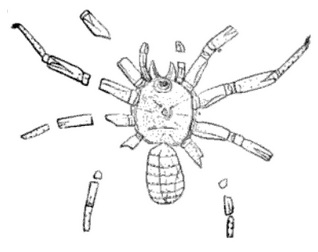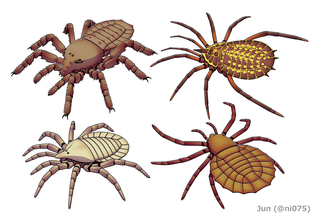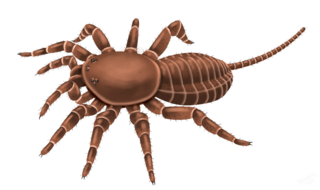
Ricinulei is a small order of arachnids. Like most arachnids, they are predatory, eating small arthropods. They occur today in west-central Africa (Ricinoides) and the Americas as far north as Texas. As of 2021, 91 extant species of ricinuleids have been described worldwide, all in the single family Ricinoididae. In older works they are sometimes referred to as Podogona. Due to their obscurity they do not have a proper common name, though in academic literature they are occasionally referred to as hooded tickspiders.

Arthrolycosidae is an extinct family of arachnids, possibly spiders. Fossils placed in the family were found in the Carboniferous to Permian, 359 to 252 million years ago. They were considered by Alexander Petrunkevitch to be "mesotheles", i.e. placed in the spider suborder Mesothelae. However, Paul A. Selden has stated they only have "the general appearance of spiders", with segmented abdomens (opisthosomae), but no definite spinnerets. At least some of the specimens placed in the family in the genus Arthrolycosa are considered to be spiders, whereas Eocteniza is "rather problematic as a spider".

Plesiosiro is an extinct arachnid genus known exclusively from nine specimens from the Upper Carboniferous of Coseley, Staffordshire, United Kingdom. The genus is monotypic, represented only by the species Plesiosiro madeleyi described by Reginald Innes Pocock in his important 1911 monograph on British Carboniferous arachnids. It is the only known member of the order Haptopoda.

The order Trigonotarbida is a group of extinct arachnids whose fossil record extends from the late Silurian to the early Permian. These animals are known from several localities in Europe and North America, as well as a single record from Argentina. Trigonotarbids can be envisaged as spider-like arachnids, but without silk-producing spinnerets. They ranged in size from a few millimetres to a few centimetres in body length and had segmented abdomens (opisthosoma), with the dorsal exoskeleton (tergites) across the backs of the animals' abdomens, which were characteristically divided into three or five separate plates. Probably living as predators on other arthropods, some later trigonotarbid species were quite heavily armoured and protected themselves with spines and tubercles. About seventy species are currently known, with most fossils originating from the Carboniferous coal measures.

Phalangiotarbida is an extinct arachnid order first recorded from the Early Devonian of Germany and most widespread in the Upper Carboniferous coal measures of Europe and North America. The last species are known from the early Permian Rotliegend of Germany.

Tetrapulmonata is a non-ranked supra-ordinal clade of arachnids. It is composed of the extant orders Uropygi, Schizomida, Amblypygi and Araneae (spiders). It is the only supra-ordinal group of arachnids that is strongly supported in molecular phylogenetic studies. Two extinct orders are also placed in this clade, Haptopoda and Uraraneida. In 2016, a newly described fossil arachnid, Idmonarachne, was also included in the Tetrapulmonata; as of March 2016 it has not been assigned to an order.

The evolution of spiders has been ongoing for at least 380 million years. The group's origins lie within an arachnid sub-group defined by the presence of book lungs ; the arachnids as a whole evolved from aquatic chelicerate ancestors. More than 45,000 extant species have been described, organised taxonomically in 3,958 genera and 114 families. There may be more than 120,000 species. Fossil diversity rates make up a larger proportion than extant diversity would suggest with 1,593 arachnid species described out of 1,952 recognized chelicerates. Both extant and fossil species are described annually by researchers in the field. Major developments in spider evolution include the development of spinnerets and silk secretion.

Megarachne is a genus of eurypterid, an extinct group of aquatic arthropods. Fossils of Megarachne have been discovered in deposits of Late Carboniferous age, from the Gzhelian stage, in the Bajo de Véliz Formation of San Luis, Argentina. The fossils of the single and type species M. servinei have been recovered from deposits that had once been a freshwater environment. The generic name, composed of the Ancient Greek μέγας (megas) meaning "great" and Ancient Greek ἀράχνη (arachne) meaning "spider", translates to "great spider", because the fossil was misidentified as a large prehistoric spider.

Anthracomartidae, first described by Haase, 1890, is a family of the extinct arachnid order Trigonotarbida. It is likely to be most closely related to the Archaeomartidae, based on a 2014 cladistic analysis, within the clade.

Arthrolycosa is an extinct genus of arachnids, possibly spiders, that lived about 300-250 million years ago.

Eophrynus is an extinct genus of arachnids from the extinct order Trigonotarbida, which lived during the Late Carboniferous period in Europe. The genus was first described in 1871 by Henry Woodward (geologist). The name comes from Eo, meaning 'dawn', and Phrynus, an extant genus of whip spider.

Cryptomartus hindi is an extinct species of Carboniferous-aged trigonotarbid arachnid from Westphalian-aged coal strata in England and Germany.

Eophrynus prestvicii is an extinct species of arachnid belonging to the order Trigonotarbida.

Eophrynidae is a family of the extinct arachnid order Trigonotarbida. Eophrynids lived during the Carboniferous period in what is now modern Europe and North America. The family is probably found within the "eophrynid assemblage" clade:.

Uraraneida is an extinct order of Paleozoic arachnids related to modern spiders. Two genera of fossils have been definitively placed in this order: Attercopus from the Devonian of United States and Permarachne from the Permian of Russia. Like spiders, they are known to have produced silk, but lack the characteristic spinnerets of modern spiders, and retain elongate telsons.

Eocteniza is an extinct genus of arachnids containing the sole species Eocteniza silvicola, known from the Westphalian stage of the Carboniferous period in Coseley, England, about 313 million years ago to 304 million years ago. It was initially identified as a spider, but this is now doubted.
Eurypterella is a dubious genus of prehistoric arthropod from the Carboniferous period of Canada. Eurypterella ornata, the only species assigned to the genus, was originally described as a eurypterid, and was briefly mentioned as such in several accounts of North American eurypterids, though often regarded as dubious. In 2004, it was briefly regarded as possibly representing a trigonotarbid arachnid, but the tapering form and lack of divided tergites into median and lateral plates complicates such a classification. A 2007 re-examination of the holotype specimen NBMG 3002 concluded that it was too poorly preserved to be able to be identified or assigned to any particular group of arthropods, and was thus treated as a nomen dubium.

This timeline of eurypterid research is a chronologically ordered list of important fossil discoveries, controversies of interpretation, and taxonomic revisions of eurypterids, a group of extinct aquatic arthropods closely related to modern arachnids and horseshoe crabs that lived during the Paleozoic Era.

Maiocercus celticus is a species of early trigonotarbid arachnid from the Upper Carboniferous of Westhoughton, Lancashire, UK. The species was first described in 1902, with a "new species" being described in 1911 which has been proven as being a junior synonym of M. celticus.















